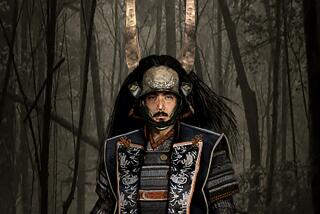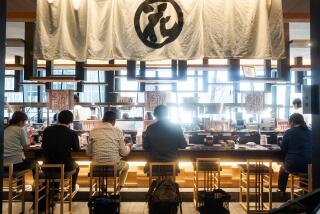AROUND HOME : Samurai Swords
THE ATTRACTION OF the Japanese sword, made for samurai warriors from the 12th Century to the late 19th Century, lies in its graceful shape and the strength of its steel blade.
The archetypal sword has a long wooden grip, a guard consisting of a flat oval or circular plate, and a slender, curved, single-edged blade. The blade was made by a much-refined process in which bars of iron and steel, after being hammer-welded together, were repeatedly folded over and forged 15 to 20 times. This produced a metal of great resilience, consisting of thousands of layers of iron and steel. These hardened steel crystals could slice through armor with ease.
Two main types of swords, differing in size and in the details of their mountings, were used: the tachi , mostly ceremonial, a slung sword worn with armor; and a pair of fighting swords ( daisho ), one long ( katana ) and the other short ( wakizashi ), which were carried thrust through the girdle of the traditional Japanese costume. The hilt was generally made of wood overlaid with the skin of a shark or a ray and bound with silk braid, and scabbards were often decorated with intricate lacquer work. The sword guard itself ( tsuba ) has become a special area of interest to collectors.
Sword making in Japan was one of the most honored of the crafts, and the process of manufacture amounted almost to a religious ritual. Peak production was reached in the late 14th Century, during the Muromachi Period. Over the centuries, a long tradition of scholarly interest has resulted in the development of a bewildering vocabulary of special terms. Each sword is unique (if imperceptibly), down to the ultimate of collector’s items: The Dojigiri sword created by the smith Yasutsuna in the Heian Period, about AD 850, is now virtually a Japanese national treasure.
It is estimated that about 5 million swords were made, and it is amazing that even one has survived. For by 1877, the government had prohibited the samurai warriors from wearing in public the two swords that were their pride and privilege and the distinctive mark of their martial caste. Often they grew so poor that they were forced to sell these treasured swords, and many blades found their way to Europe. Years later, when all weapons were banned in Japan after the surrender of 1945, an incalculable number of excellent antique blades fell into American hands. A 19th-Century sword with a relatively plain scabbard can be found at auction for $1,500 to $2,500, while an older weapon--with a signed blade and more elaborate decoration--can cost up to $50,000. Some of the finest swords are making their way back to Japan, and today many people in the United States may be the owners of valuable samurai swords without knowing it.
Japanese swords can be found at I.M. Chait in Santa Monica (auctions); Larchmont Japanese Antiques in Hancock Park; Japanese Arts and Armor in Los Angeles; Collector’s Armoury in Culver City; Warren Imports in Laguna Beach, and Quartermaster Stores in San Diego.


